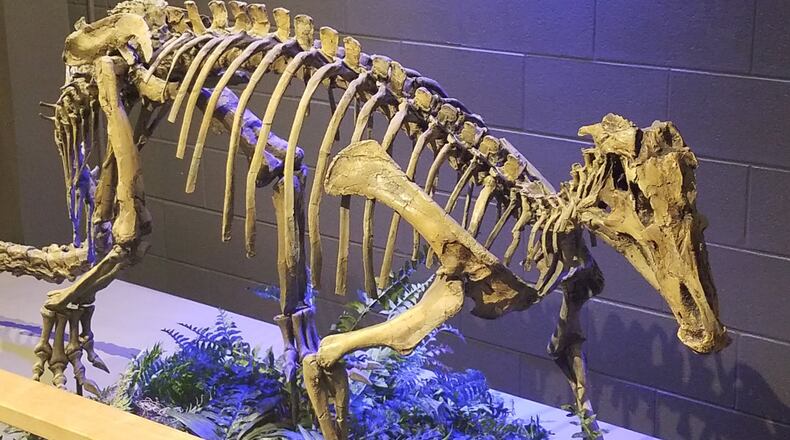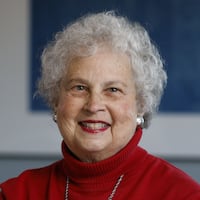>>People who’ve had bucket-list adventures want to inspire YOU to do the same
As for what’s new, it’s president and CEO Tracey Tomme, who took over the job in December. “Two big ways to excite young learners are ‘space’ and ‘dinosaurs’ and we’ve got those covered,” Tomme says.
Meet the dinosaurs
The current dinosaur exhibit, on loan from the Virginia Museum of Natural History, will be on display in the museum’s Main Hall through April. If you stop by on a weekend, you can watch the museum’s paleontologist, Mackenzie English, work on a dinosaur bone he’s currently cleaning and repairing. You’re free to ask questions as he works.
“You get to be a kid,” says English about his choice of vocation. “It’s what most kids wanted to do when they grew up and I just never grew up.”
>>Heeere’s Andrew! Dayton getting brand new late-night TV talk show
“How can we not be excited about dinosaurs?” asks Dawn Kirschner, the museum’s vice president of education who wasn’t surprised when 1,200 people showed up for the exhibit opening Jan. 26. “They spark interest across generations.”
Initially, she says, we’re fascinated by the gigantic dinosaurs with their great large teeth, but once we begin to learn more about them, we become interested in other varieties as well. “More than 700 species have been discovered and we’re still discovering new ones,” Kirschner says. “You really never know what’s under you, wherever you go, including in the Miami Valley where Ice Age mammals once lived.”
This new exhibit is a great introduction to dinosaurs. You’ll learn when and how they lived and meet a variety of fascinating dinosaur species. The displays you’ll see are a combination of fossilized bones and casts. (The “real” bones are the ones in cases.) The big news — and it’s BIG — is the 65-million-year-old skull of a large Hadrosaur. The skull now belongs to the museum, thanks to Pete Thaler, who donated it in honor of his children, Mason and Evan. Known as Anatotitan copei, this “duck reptile” was discovered in Butte County, South Dakota in 2001.
Among the other dinosaurs represented in the show are Tenontosaurus, a plant-eating dino who was 20 feet in length, weighed two tons, and had a narrow head and a long tail. You’ll see a life-size Triceratops skull with a horn indicating this Trike survived an attack from a T. rex; the X-ray shows evidence of scar tissue and tooth marks that match no other known dinosaur from the same place and time. Next to the real Triceratops stands “Cera,” an animatronic Triceratops that begins to move when you push a button.
>>BEST OF DAYTON 2018: The 3 best grilled cheeses you can find in Dayton
You’ll learn that close relatives of T. rex had feathers and that current speculation is that T. Rex may have had feathers as well. Check out the toe and tooth of an allosaurus.
The second half of the exhibition is geared toward families with young children. It’s an activity maze that will answer lots of basic questions. Be sure and pick up a “passport” and help your kids fill in the blanks. They’ll stop at computer stations, learn to estimate how fast dinosaurs moved, don costumes and measure themselves against a Brachiosaurus.
Credit: Boonshoft Museum of Discovery / Michael Sampson
Credit: Boonshoft Museum of Discovery / Michael Sampson
Other Boonshoft changes
If you haven’t been to the Boonshoft in a while, you’ll note a lot of changes. Renovations underway are part of a long-term plan to improve the museum from the infrastructure out — plumbing, ventilation in the labs, modern work spaces. At the moment, restrooms are being updated, as are the Do Lab and Science Theater.
Lego-lovers will be delighted to discover the new Strickly Briks area, created in 2018. The spacious room replaces the old activity station formerly located in a high traffic area that wasn’t so conducive to building. This new space, located neat the Tidal Pool, features extended platforms for constructing and a large assortment of colorful bricks donated by the Strictly Briks company. There are also some nice places where the grown-ups can relax while still keeping an eye on the kids. The Briks are also available for sale in the museum gift shop.
>>Who should be added next to Dayton’s Walk of Fame? Committee seeking your nominations
Those who didn’t get the chance to see the Explorers exhibition that opened in the Main Exhibit Hall in January of 2018, will find it now located in the smaller Fraze Gallery. The show, which honored the 125th anniversary of the collection, is based on the five main areas of the world. Highlights include Nesiur, the museum’s mummy, as well as Egyptian artifacts including masks, canopic jars and mummified animals. There are also Japanese kimonos and musical instruments.
Meet Tracey Tomme
The museum’s new director has impressive credentials. Most recently she was executive vice president and chief operations officer at the Cosmosphere International Science Education Center and Space Museum in Hutchinson, Kansas. The Cosmosphere houses more than 13,000 spaceflight artifacts, the largest combination of U.S. and Russian spaceflight artifacts in the world. Before that, she worked at the Challenger Learning Center in Colorado Springs.
We chatted with Tomme in her unusual dome-shaped office, the museum’s former planetarium, where she’s surrounded by a seven-foot tall polar bear standing on hind legs, a large wooden ancestral figure from New Guinea, sparkling quartz and amethyst. Comfortably ensconced behind her desk is a live specimen — Tomme’s 7-month-old Australian Shepherd, Abi, who regularly joins her at work.
Q. What kind of child were you?
A. I was a quiet, shy kid who spent my days as close to my mother as possible, playing with my plastic farm animals while she quilted or crocheted. I was determined I would manage a horse ranch and potentially never leave home. My parents divorced when I was around 8 years old and my mom worked two jobs to keep us going through some really lean times. She taught us that education was important. While at college I studied animal science and met my husband who was an Air Force pilot. I taught middle school science and we moved all around the U.S., England and Germany.
Q. What attracted you to the job in Dayton?
A. My husband, Ed, had a very positive impression of Dayton based on many trips he had made here to give briefings or attend meetings. Once I came and visited, I realized how amazing it is. The city was very welcoming. I took a day to visit all three museum sites: The Boonshoft, Fort Ancient and Sun Watch and was impressed at the quality, cleanliness and collections. I love the abundance of learning activities for children and families. I told my husband it would be my dream job!
Q. What are some of your museum’s challenges?
A. Almost all museums today are facing funding issues. The public finds the ticket price to be high, schools are taking fewer field trips, funders are cutting back, some of the big philanthropic companies have left towns; these are all common observations when trying to balance museum budgets. In reality our ticket price is so low that there is no way to balance the budget by simply bringing in more visitors. We, of course, want to continue to grow the number of visitors who come and benefit from our facilities.
I believe we are as lean as we can be without affecting the visitor experience. We have already cut staff, turned off lights, adjusted thermometers and everything we can think of to save much-needed dollars. Now what we have to do is find new, creative funding streams. Our current earned revenues are around 30 to 35 percent of our total budget. That leaves a big gap of money that has to be filled through donations, grants and endowment income.
My goal is to get up to 75 percent and build the endowment so we can have long term stability. We did that at the Cosmosphere and I know with our talented staff it can happen here. I will be diligently looking for donors who agree with our mission and value to the community and are willing to help support us toward this next more sustainable phase.
Credit: Boonshoft Museum of Discovery / Michael Sampson
Credit: Boonshoft Museum of Discovery / Michael Sampson
HOW TO GO
What: "Dinosaur Discovery," real dinosaur fossils from the Mesozoic era on loan from the Virginia Museum of Natural History.
Where: Boonshoft Museum of Discovery, 2600 DeWeese Parkway, Dayton
When: Through April 14. Hours are 9 a.m. to 5 p.m. Monday-Saturday, and noon to 5 p.m. on Sunday.
Admission: $14.50 for adults, $12.50 for seniors 60+, and $11.50 for youths 3-17. Members and children 3 and under are free.
More info: (937) 275-7431 or www.BoonshoftMuseum.org
SENSORY SERIES PLANNED: On Sunday, Feb. 17, the Boonshoft Museum presents Sensory Sunday. This will be the first of four programs throughout the year designed to make the museum more accessible for families with a member on the autism spectrum.
About the Author







